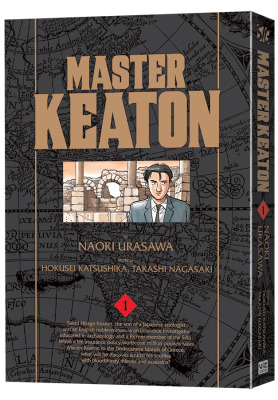Naoki Urasawa has had a long and illustrious career as a creator of original, thoughtful and action-packed manga like Monster, 20th Century Boys, 21st Century Boys and his reworking of Osamu Tezuka’s Astro Boys for an older audience, Pluto: Urasawa × Tezuka. He’s done action-adventure, psychological thrillers and even romantic comedy.
Master Keaton – an answer to Indiana Jones and other pulpy heroes – may have a story (and a very good one, at that) by Hokusei Katsushika and Takashi Nagasaki, but it’s Urasawa’s art that elevates it from very good to classic.
Taichi Hiraga Keaton is the son of a Japanese zoologist and an English noblewoman. He lectures in archaeology at a small Japanese college (he has a degree in the subject from Balliol College, Oxford) and works on a freelance basis with Lloyd’s of London as an insurance investigator. He looks like a quiet studious sort, but is ex-SAS.
The first volume in the 12-volume Master Keaton manga series opens with the death of Leon Pappas, whose million-dollar insurance policy benefitted Ochs Fine Art Ltd, in the village of Isidoros in the Dodecanese Islands. Keaton is, of course, asked to investigate.
It’s the first of a number of cases he tackles – while continuing his lectures and visiting his teenage daughter Yuriko (even defending her stand in class on the subject of ‘The Four Great Civilizations’ – to the immense displeasure of her homeroom teacher) – and it seems like what we’re getting is more a series of vignettes than a single narrative.
As the story continues, and we learn more about Keaton (including the origin of the series’ title, Master Keaton), it becomes clear that we are being drawn into a larger narrative. Elements of many the vignettes thread together in unexpected ways. A perfect example is the story of a ring that winds up in Keaton’s possession – or the story of how a strange artifact proves essential to survival in a desert.
Katsushika and Nagasaki have done a lot of research to get the historical and archaeological details right and Urasawa has, as well, to capture the most important physical details of the story accurately.
Throughout, Urasawa’s layouts are dynamic and utilize space in unexpected ways (a tiny panel might be composed of just Keaton’s face as he ponders or asks a question with succeeding panels growing larger as information comes in; fight sequences flow like the type of action contained within them).
His art ranges from beautiful fine linework to something resembling sketches – only with dark, bold lines. His characters are expressive and he avoids the artist’s trap of working with a finite set of facial types – the only time his characters look alike is when they’re supposed to (Yuriko, for example, looks a lot like her mother…).
Considering Urasawa’s popularity here, it’s odd – and a bit of a shame – that Master Keaton hasn’t been available here before. It certainly stands up well with the best of more recent manga releases.
Final Grade: A
